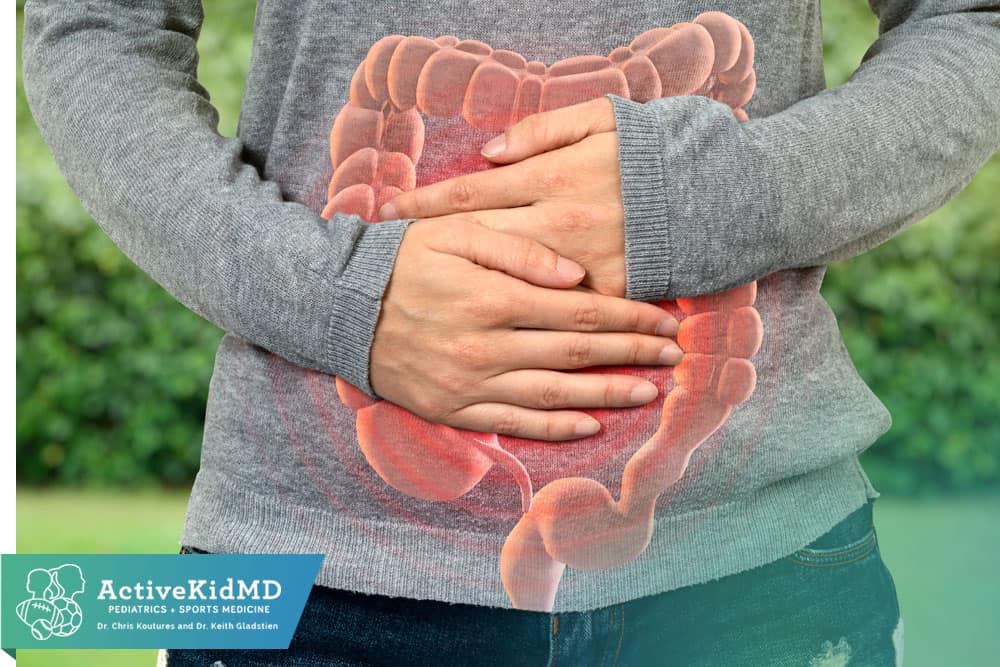Bowel movements are a part of life and having harder stools with constipation can cause discomfort for babies, children and their parents. Read on for more information on what constipation exactly is, tips on how to treat it, and when you should contact your doctor for an office visit.
WHAT IS CONSTIPATION?
Constipation can be defined as having hard stools that come out round and often cause pain. Sometimes there can be blood seen in the stool.
Please note that constipation is not just infrequent stools.
Skipping days between bowel movements is not a problem if the stools are soft and easily passed without discomfort. Children, even infants, can go several days without a stool. If they are happy and feeding well, then there is less reason for concern.
Some children with constipation will have frequent diarrhea. Liquid or looser stools are often the only thing that can pass by the harder stools stuck in the lower part of the digestive tract. Older children may have stool accidents or leakage in their underclothing.
WHY DO HARD STOOLS HURT?
Having round hard stools means the anus may be stretched beyond capacity and this stretching is painful.
TREATMENT

For everyone else treatment is divided between infants and non-infants.
- Infants (before solid foods introduced)
- If your baby is breastfed and having hard stools, call your pediatrician. Remember skipping days between bowel movements is not a problem and is normal, especially in breast-fed babies that are 3 months of age.
- If your baby is formula fed, add a water feeding (about 4 ounces) to the daily diet. If your baby does not like water, add just enough table sugar so your baby willing drinks this. If that does not stop the hard stools, call your pediatrician. It may be necessary to add some prune juice to the diet or change the formula.
- Everyone else older than infants
- First, stop giving constipating foods (like bananas, apples or applesauce, rice or rice cereal, and fatty foods).
- Next, give prunes, peaches, pears, apricots, and plums or those juices. Sometimes you must be creative to get children to take these fruits or juices. Some parents mix prune juice with 7-up to make the prune juice more appealing. Having hard stools is one of the few times that we recommend giving juices to a child.
- In addition to the fruits and juices, you can give one capful of over-the-counter MiraLAX powder in 8oz of (any) liquid to your child. You can give this as many times per day as needed to soften the stool. When using MiraLAX, you can stop giving this once the stools become almost like a clear liquid. Some parents will continue giving the MiraLAX once or twice a week to help keep stools softer. If the MiraLAX doesn’t make the stools looser after 3-4 days of use, please contact your pediatrician for an appointment.
- Regular use of suppositories or enemas is not recommended. If you feel the need to use these, please contact your pediatrician first to discuss the best options for you and your child.
HOW LONG SHOULD YOU TREAT CONSTIPATION?
Constipation is usually not a short-term problem. It will continue until the situation that caused the constipation changes. Since the cause is usually some change in your child’s appetite/diet, the tendency towards constipation is going to be present at least until your child’s appetite/diet changes again.
WHAT CAN HAPPEN IF CONSTIPATION IS LEFT UNTREATED?
The biggest problem occurs when a child has had enough painful stools to fear the passage of the next stool. Then your child may try and hold the stool inside (to prevent the painful experience). This starts a vicious cycle. The longer the child holds the stool, the harder and bigger (and more painful) the stool will be when passed. That more painful passage reinforces the fear, and the child tries (with more determination) to hold the stool inside longer the next time resulting in the next stool being even more painful.
Further, it is not unusual for this fear of passing a painful stool to lead to inability to relax and pass even a soft stool. Consequently, children will try to hold soft stools when the memory of painful stools is recent. You can estimate that the length of time it will take for a child to begin to relax at stool, once they start having soft stools, is about twice the length of time that they had hard stools.
In older children (and adults) the desire to pass the hard stool will usually result in excess pushing. This increased pushing can lead to dilated blood vessels (hemorrhoids) around the anus that cause further pain (and swelling with blood clot formation) and bleeding.
WHEN SHOULD YOU SEE THE DOCTOR FOR CONSTIPATION PROBLEMS?
If you cannot quickly control constipation using the above information, please call your pediatrician for an appointment. If you notice red blood, black/brown streaks, or other unusual colors in the stool, please also contact your pediatrician for an evaluation.


